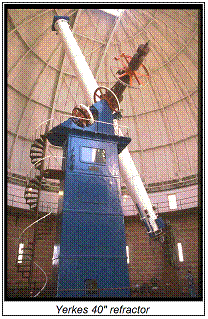Yerkes Observing Log: Burnham and Double Stars
Jack Kramer
Quite naturally, we tend to focus on the discoveries coming from the new technology telescopes that have been built recently. On the other hand, we live not far from Yerkes Observatory -- one of the great research institutions of history. It might be interesting to take a look now and then at some of the people, instruments, and discoveries that made Yerkes famous in its heyday.
The story of S. W. Burnham (not of Burnham's Celestial Handbook fame) is a classic tale of "local boy makes good". He began his working life as a court reporter in Chicago, but he was also a zealous amateur astronomer. When Yerkes opened, he joined the staff, working without pay. After awhile, his keen observing skill and resultant discoveries became so important that until he became a full-fledged staff member, George Ellery Hale, the director, began paying Burnham a salary out of his own pocket.
One of Burnham's major efforts was to understand the nature of double and triple stars, which actually constitute a large percentage of the stars visible to us. By watching their movement over time, it could be determined how they move with respect to each other and verify whether they are gravitationally bound. After acquiring a multiple star in the 40-inch refractor, he would center one of the group at the zero point of a micrometer scale and measure the distance between the components in thousandths of an inch. This was difficult enough, but bear in mind that some of the best seeing occurs during the winter months, at a time when the temperature at Williams Bay, Wisconsin, is well below zero. The micrometer screws required that the observer use bare fingers and the adjustments took many hours of continuous work. How about those working conditions?
The 40" refractor's resolving power is one-tenth of an arc second -- 0.10". (A typical 10" scope has a resolving power of about 0.45".) This means that it can separate discrete star images that are only 1/36,000 of a degree apart. In order to reach that limit, Burnham had to learn to measure distances of only 3/10,000 of an inch. I'd call this a good case of eye and hand coordination!






